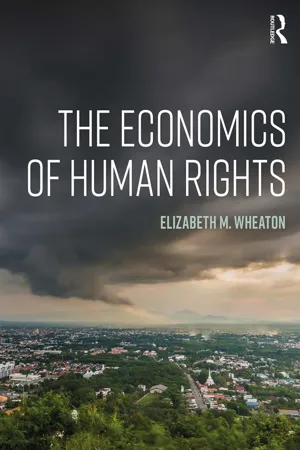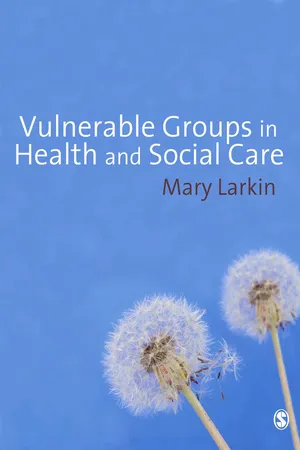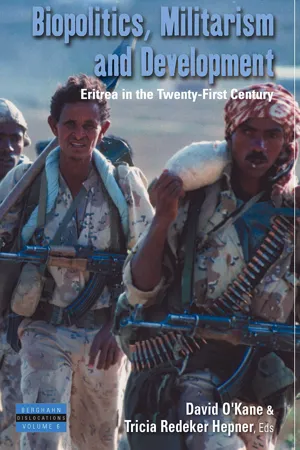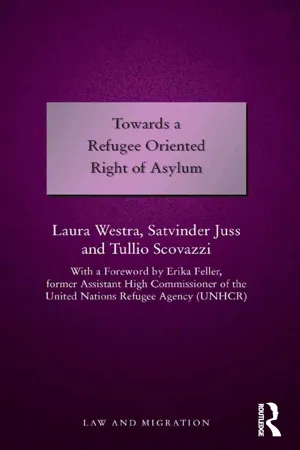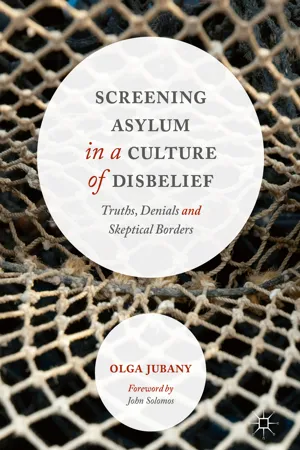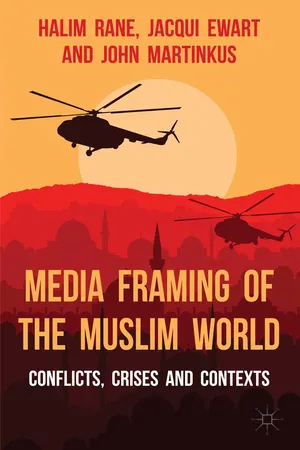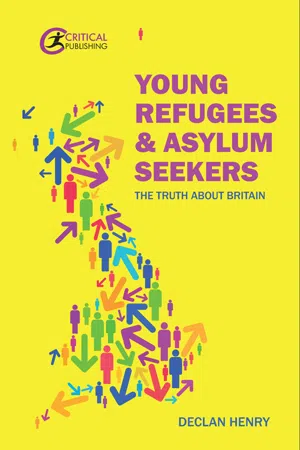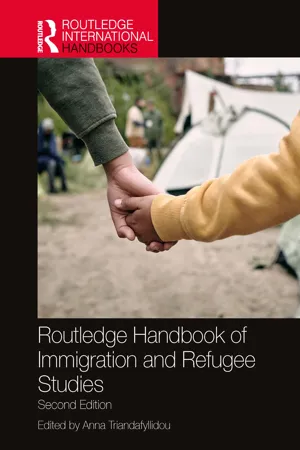Geography
Asylum Seekers
Asylum seekers are individuals who have fled their home countries due to persecution, conflict, or human rights abuses and are seeking protection in another country. They often apply for refugee status and await a decision on their asylum claims. The geography of asylum seekers involves understanding the patterns of migration, the distribution of asylum seekers across different regions, and the factors influencing their movement.
Written by Perlego with AI-assistance
Related key terms
1 of 5
9 Key excerpts on "Asylum Seekers"
- eBook - ePub
- Elizabeth M. Wheaton, Elizabeth Wheaton(Authors)
- 2018(Publication Date)
- Routledge(Publisher)
asylum is the protection granted by a nation to a person who has left their country of origin in order to escape violence or persecution. Definitions regarding seeking asylum differ and are written to conform to international, national, and regional policies. This textbook incorporates definitions from the top international and national agencies, including UNHCR and the U.S. Citizenship and Immigration Services (USCIS).UNHCR was created to protect the lives and human rights of refugees, Asylum Seekers, and internally displaced and stateless people. This agency works with people who have fled from their homes due to violence, persecution, war, or disaster. They provide items for emergency assistance, transportation, and income-generating projects. The goal is to provide each displaced person with the opportunity to return home or resettle in a safe place. Below are some of the definitions from this international agency that are relevant to seeking asylum.According to UNHCR, a refugee is someone forced to flee their country due to violence, persecution, or war. The term refugee is defined under international and regional law. A refugee may move from one host country to another host country and is afforded the same legal protection. An asylum seeker is a person who is inside or outside the borders of a nation and appeals to the nation for asylum, but who has not yet been granted asylum. The goal of seeking asylum is to gain protection and material support from the asylum-granting nation. The asylum seeker must provide specific evidence as to why they fear persecution in the home country.Persons who are caught in a country illegally can be expelled from the country in a process called refoulement . International law provides for non-refoulement for Asylum Seekers, meaning that a person who applies for asylum cannot be forcibly returned to their home country without a determination of need for asylum.The term migrant has an international, standardized definition. It is understood that a migrant is someone who voluntarily crosses a border to seek better economic, educational, and social conditions or to join family. For example, an economic migrant is a person who seeks employment in another country. This does not include seeking asylum. The media often uses the term international migration - eBook - PDF
Seeking Asylum and Mental Health
A Practical Guide for Professionals
- Chris Maloney, Julia Nelki, Alison Summers(Authors)
- 2022(Publication Date)
- RCPsych Publications(Publisher)
For example, at the end of June 2019, the South East and East of England had the fewest Asylum Seekers relative to their populations at 0.01%, compared with 0.19% in the North East. Glasgow was the local authority with the highest number overall (Walsh, 2019). Box 1.3 Some major diasporas 2011–2020 The number of forcibly displaced people around the world has more than doubled since 2011. • Approximately 4.5 million Venezuelans fled political and socio-economic instability and a humanitarian crisis to countries across Latin America and the Caribbean within the latter part of the decade, peaking in 2019. • From mid-2017 onwards, violence in Myanmar led to more than 700,000 Rohingya Muslims, a persecuted, stateless minority, fleeing to Bangladesh, subsequently rising to more than a million. • Conflict in Yemen from 2015 led to the displacement of more than 3 million people alongside a critical humanitarian crisis. Why do people seek asylum? The global context 15 The context of seeking asylum Humans have long migrated over the earth, often moving their homes far from where they were born or where they lived their early lives. Some were nomadic farmers, following the rain, seeking food and water, or pasture for their livestock. Then, as societies became more developed, people sought work and economic stability, education and opportunity, and the chance to join family or friends elsewhere. At the same time, some travelled to conquer new territories, build empires, and take whatever they could find. Others, perhaps as a conse- quence, were forced out of, or fled, their homes, escaping danger or persecution to seek refuge elsewhere. Involuntary migration has a long history over many different geographical areas, cultures, and religions. A right of asylum was recognised by the Egyptians and Ancient Greeks, and was offered by major world religions, usually associated with the inviolability of holy places. - eBook - ePub
- Mary Larkin(Author)
- 2009(Publication Date)
- SAGE Publications Ltd(Publisher)
Chapter 8
Asylum Seekers and Refugees
OVERVIEW
- Definitions
- Reasons for seeking asylum in the United Kingdom
- Vulnerabilities upon arrival
- Life in the United Kingdom for Asylum Seekers and refugees
- Existing policies and initiatives that address the social exclusion of Asylum Seekers and refugees
- Directions for future policies
- Conclusions
- Suggestions for further study
INTRODUCTION
Wars, conflicts, human rights abuses and environmental disasters in different parts of the world result in the enforced migration of civilians to other countries. Although their numbers fluctuate, there are around 21 million Asylum Seekers and refugees worldwide who have fled their homes in the world’s trouble spots. Their plight is a cause for global concern and action at an international level to ensure their protection and to resolve problems is coordinated by the United Nations High Commissioner for Refugees (UNHCR).Therefore global events and processes influence the ways in which the United Kingdom is affected by asylum and refugee issues; for instance in the 1970s there were Asylum Seekers from Chile, and then from Vietnam in the early 1980s. The numbers of those coming to the United Kingdom to seek asylum increased in the 1980s and 1990s because of the situations in countries such as Kurdistan, the former Republic of Yugoslavia, Somalia and Uganda. These increases, together with concerns about costly delays in processing their applications and abuse of the asylum system, considerably raised their political profile in the 1990s. Research into the lives of Asylum Seekers in this country highlighted their marginalisation from mainstream society. The media also played a significant role in increasing their visibility and raising public awareness with images of Asylum Seekers in holding centres and living in areas of severe deprivation. They have been prioritised within the social exclusion agenda and the Social Exclusion Unit identified them as being amongst the ‘hardest to help’ (Social Exclusion Unit, 2004a: 5) groups in society. Other sources have described them as among the ‘most vulnerable groups in the United Kingdom’ (Mollard, 2001: 12) and ‘among the most vulnerable of vulnerable groups’ (Burchardt, 2005: 210). Consequently there have been several major policy interventions which have attempted to address the problems associated with asylum in the United Kingdom (Sales, 2002; Roche 2004; Burchardt, 2005). - eBook - ePub
Biopolitics, Militarism, and Development
Eritrea in the Twenty-First Century
- David O'Kane, Tricia Redeker Hepner, David O'Kane, Tricia Redeker Hepner(Authors)
- 2009(Publication Date)
- Berghahn Books(Publisher)
Departing Eritrea proper, however, does not mean that one is beyond either the national terrain or the reach of the government. All Eritreans who migrate abroad are inserted into the transnational social field that conjoins the diaspora and the party-state into a single, if differentiated, entity. Thus, when Asylum Seekers arrive in the United States, they enter into a vast network of cross-border relationships, institutions, and policies that has long been controlled by EPLF/PFDJ. While marked by conflict since its founding in the 1970s largely due to the tensions among ELF and EPLF political identities and the struggle for popular sociopolitical autonomy vis-à-vis the EPLF/PFDJ, this transnational social field has intensified in recent years as the primary battleground where coercive state power across long distances meets the heightening struggle for democratic praxis and rights among citizens abroad. As the party-state in Eritrea eradicates all social institutions it cannot fully co-opt or control, and removes from the national community or territory people who represent oppositional views or unwelcome aspects of globalization, these re-emerge in the transnational social field that has long comprised part and parcel of Eritrea. Recent Asylum Seekers play an important role in this development.Experiencing Asylum: Policy, Law, and Rights as Constraint and ConsciousnessSeeking asylum is no easy task; it requires ingenuity, courage, resources, emotional and psychological strength, resilience, and patience (see Leach and Mansouri 2004). Anecdotal evidence gathered by new US-based organizations such as the Eritrean Community for Human Rights and Refugee Protection indicate that Asylum Seekers often traverse a dozen or more countries and must raise more than US$10,000 to shoulder the costs (Yonas Mehari 2007). This suggests that most Asylum Seekers who make it to the United States are privileged by local standards and/or well connected to friends and relatives abroad who can help support their dangerous journeys. Others who declare asylum do so after they have already been able to come to the US by other means, such as on student visas. The alternatives for their less privileged or unlucky compatriots include languishing in refugee camps across international borders, hoping to be registered and resettled by the UNHCR; fleeing to nearby countries such as Egypt, Sudan, Kenya, or Uganda and living there illegally; and attempting to cross the Red Sea or move northwest through Libya, where a boat to Malta may be taken as a way-station to Europe. Many who try do not make it (see Plaut 2007).The right of asylum, and the obligation of countries not to return Asylum Seekers to countries where they will be persecuted (non-refoulement) - eBook - ePub
- Laura Westra, Satvinder Juss(Authors)
- 2016(Publication Date)
- Routledge(Publisher)
Chomsky 2014 : 2). This separation is especially important as it affects refugees at all points in their saga: in the exposure to the conditions that render them Asylum Seekers; in the situation they find, when they are lucky enough to be able to flee; and even in the conditions of life they find when they reach their goal – life in another country.The first aspect of this situation was emphasized in Chapters 2 , 3 and 4 of this work. Juss puts it well:When one considers the root causes of flight in many developing nations, however, it is clear that a focus on narrow political interpretation of persecution excludes the bulk of the world’s refugees today, thereby making such a definition wholly inappropriate for a global application. Thus the definition can exclude those suffering economic and social persecution. It can exclude those suffering from the effects of war. It can exclude the victims of natural disasters in countries where the state offers no protection. It can accordingly all too easily exclude the migration of people attributed to climate change. In short it excludes most of the world’s humanitarian refugees (Juss 2006 : 171).It seems clear that the effort to render refugee law more relevant, thus ensuring a better fit between its regulations and the situation of those it is intended to protect, should be to switch the focus of relevant regimes to human rights. As well, the attempt to separate the conditions and the needs of Asylum Seekers from that of migrants is not conducive either to an understanding of the causes and conditions leading to the forced exodus of whole groups, or even to better knowledge of the situation of refugees who succeed in their flight, after their arrival in their chosen country.For many reasons connected to the presence of ‘global apartheid’, the main issue regarding today’s Asylum Seekers is the existence of multiple human rights breaches; we need to respect their dignity and their rights from the start. Their rights must be respected at their original location, at the start, as mass flights are better reduced by eliminating the causes than by attempting to redress the problems after they have occurred. In addition, their rights must be respected at the border, after they flee, if the harmful conditions that face them persist. Finally, their rights must be respected after their arrival. - eBook - PDF
Screening Asylum in a Culture of Disbelief
Truths, Denials and Skeptical Borders
- Olga Jubany(Author)
- 2017(Publication Date)
- Palgrave Macmillan(Publisher)
This debate developed within the context of growing nationalistic influences, post-colonialist stands and racist arguments about the failure of multiculturalism and the notion that cultures and societies were under threat from an outside influence (Cohen 2002). At this time, the per- ceived threat was not widely associated with state ‘security’ perspectives, but developed along the lines of the asylum seeker as a cultural menace and a burden to the already beleaguered state. The immediate response of most European nations was to remove resettlement programmes, mark- ing the end of any convergence of interest in the previously symbiotic relationship (Koser 2001). This era was the point where refugees became transformed into Asylum Seekers that, as Koser argues, ‘now had to arrive 46 Screening Asylum in a Culture of Disbelief independently and prove their claims’ (ibid: 88). This major conceptual shift developed alongside the notion that asylum was a charity offered by the state, and not a right of the asylum seeker. A further effect of this has been the blurred distinctions between economic migrants and political refugees, which continued to develop and take new turns during the 1990s, providing new avenues by which the denial of asylum seeker rights could be pursued (Cummings et al. 2015; Loescher 2001). The flexibility of the term ‘asylum seeker’ began to emerge and, throughout the 1990s, it would become a key tool states would use to achieve their immigration goals as they moved further away from the ethos of the Convention (Lazaridis 2015). The deconstruction of the concept of refuge thus began, and the loose interpretation of the ‘right to asylum’ led to further inconsistencies in asylum politics and policies (Koser and Lutz 1998; Joly et al. 1992). Furthermore, since the 1980s calls began to be made to link issues of migration to wider understand- ings of security as the prospect of the collapse of the Soviet Union became more real (Huysmans 2006). - eBook - ePub
Media Framing of the Muslim World
Conflicts, Crises and Contexts
- H. Rane, J. Ewart, John Martinkus(Authors)
- 2014(Publication Date)
- Palgrave Macmillan(Publisher)
4 Asylum SeekersGiven the extent of pejorative political, media and public discourse on Asylum Seekers, particularly where Muslims are concerned, it is ironic that migration and particularly asylum seeking have a special place in the Islamic tradition. At the advent of Islam in 610, many of the early converts to the new monotheistic faith were severely persecuted by the polytheistic Meccans. Muhammad instructed the weakest and most vulnerable of his followers to emigrate from Arabia and seek asylum under the protection of the Christian king of Abyssinia (modern-day Ethiopia). Moreover, in the year 622 the rest of the Meccan Muslim community, including Muhammad himself, migrated to a town called Yathrib (later named Madina) almost 280 miles (about 450 kilometers) to the north, where they were given asylum by the people of the town. This migration, known as the hijra in Arabic, marks year one on the Islamic calendar, as it was from this point in time and space that the religion of Islam began to take shape in terms of its characteristic rituals and laws (Rane, 2010a).This chapter is concerned with the growing numbers of people around the world who have been forced to seek refuge in other countries. A large proportion of these Asylum Seekers are Muslims fleeing war, conflict and political repression in their own countries. Particularly since the turn of the century, however, some Western media have represented Asylum Seekers unsympathetically, as undeserving and opportunistic and as potential criminals and terrorists. The policies of certain Western governments have violated the rights of Asylum Seekers and attempted to deter them from applying for asylum. Public opinion in many Western countries has also hardened and concern about the arrival of Asylum Seekers is widespread. This chapter examines the relationship between media coverage, public opinion and policy making in respect to the asylum seeker debate and attempts to explain the direction of influence and implications for intercommunity relations. - No longer available |Learn more
Young Refugees and Asylum Seekers
The Truth about Britain
- Declan Henry(Author)
- 2020(Publication Date)
- Critical Publishing(Publisher)
Those claiming asylum do so because of their appalling situations. Smugglers run profitable businesses – many are dangerous criminals who prey on the vulner -able and the desperate. Young people often lose their identity after they leave their home country, where they were often (or their family was) of high standing – now, nobody knows them. They are seen just as Asylum Seekers or refugees – their sense of identity has gone. Some young people travel from country to country seeking a secure sanctuary, presenting as ‘lone rangers’ seeking friendship, food and shelter in a world that often appears volatile, distrusting and unsafe. Although many come from good backgrounds in their home countries, they often have to live feral lifestyles to survive their journey to the UK. They face daily dif ficulties and challenges that impact 81 ASYLUM PITFALLS greatly on their physical and emotional health as they navigate their way through uncertainty, hampered by language dif ficulties and little money. Dariush (17) from Iran Dariush said that after he left Iran, he travelled through Turkey, Italy and Germany before eventually ending up in Sweden. He was under the control of the agents from the start of his journey until he reached Sweden. Dariush destroyed his pass-port when he reached Turkey because the agent told him to do so in case he was searched and his identity was revealed. He feared this might prompt the author-ities to return him home to Iran. Dariush stayed in Sweden for six months where he claimed asylum, but he felt sad most of the time and didn’t care if Sweden granted him asylum because he found the place to be very racist. He said there were 12 other Asylum Seekers living in the same village as himself. Dariush added that the local people hated them and would always look at them with angry faces and shout, telling them they were Arabs who would ruin their country. Dariush was glad to leave Sweden because he felt so unhappy and unwelcome there. - Anna Triandafyllidou(Author)
- 2022(Publication Date)
- Routledge(Publisher)
Yet migration is in many senses mixed, and at all stages of the migration process, not just in the sense that migrants and refugees make the same journey. Migration motivations may overlap, as those fleeing conflict, human rights abuses, and persecution will also be leaving economic instability and poverty: they will want not merely to save their lives, but to find work and make a living once they arrive in a place of safety. Similarly, those who come in search of employment may be excluded from work or education in their country of origin because of their gender, religion, or ethnicity. Those who leave looking for work may be forced to move again because of discrimination. In the countries where people settle, those who arrive as refugees will join labour migrants in the competition for accommodation, education, and employment.All this makes it difficult to distinguish neatly between migrants, asylum-seekers, and refugees – a reality increasingly accepted by migration and asylum experts. Yet there is continued insistence that such a distinction is necessary. Refugee advocates are committed to ‘disentangling refugees to ensure their proper protection’ (UNHCR 2011 ), while states argue that ‘the principle of asylum is better defended when access to it is restricted’ (Fassin and Kobelinsky 2012 ), though their concern is clearly with controlling migration and ensuring that asylum does not become an open gateway for all.Why is it necessary to distinguish between refugees and migrants?
The issue arises because in the twentieth century developed states formalised a commitment to protect refugees. This commitment was limited to those who meet the criteria specified in Art.1 of the 1951 Geneva Convention Relating to the Status of Refugees and who either manage to reach the territory of European states or who have been selected from refugee camps in Indonesia, Iran, Kenya, or Pakistan to fill the quotas of a small number of developed countries such as Australia, Canada, the US, and a handful of EU member states.1
Index pages curate the most relevant extracts from our library of academic textbooks. They’ve been created using an in-house natural language model (NLM), each adding context and meaning to key research topics.
